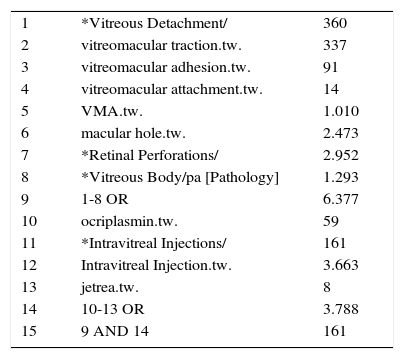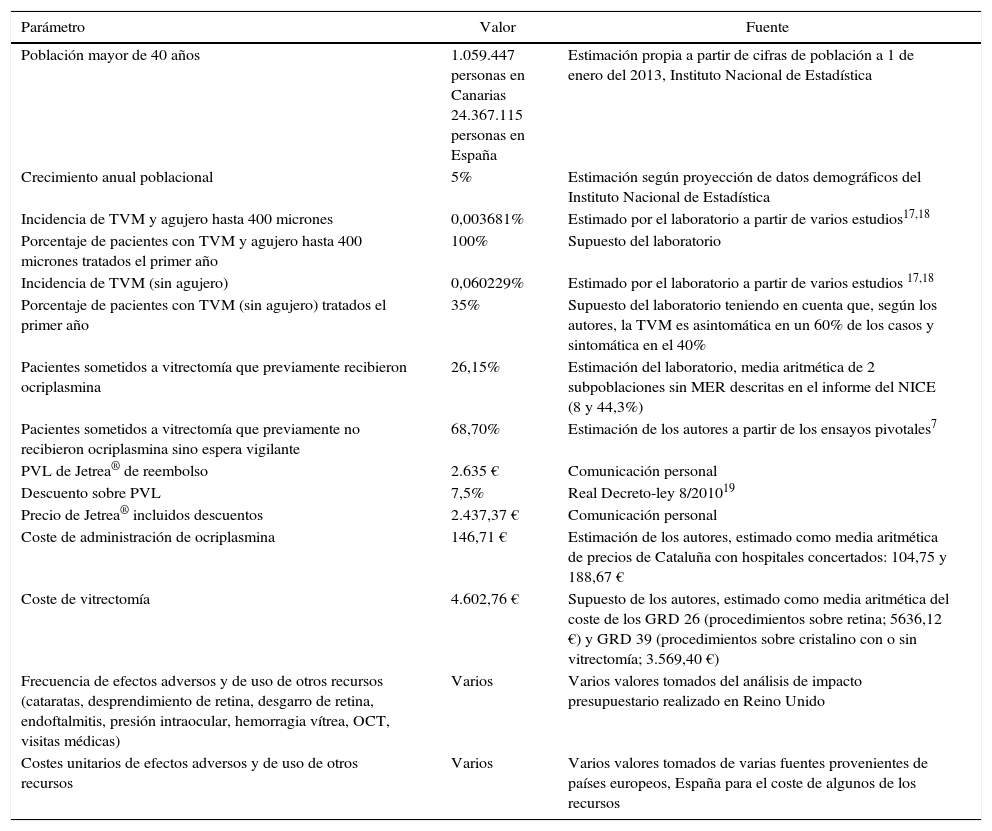Revisar las pruebas sobre el coste-efectividad de la ocriplasmina para la tracción vitreomacular (TVM) y estimar el impacto presupuestario que supondría su uso en el Sistema Nacional de Salud (SNS).
Material y métodos1) Revisión sistemática. Se realizaron búsquedas en enero del 2015 en MEDLINE, PREMEDLINE, EMBASE, CRD y The Cochrane Library, y páginas web clave. Se incluyeron evaluaciones económicas completas que comparaban ocriplasmina con tratamiento habitual (espera vigilante y/o vitrectomía) en pacientes con TVM. Las medidas de resultado de interés fueron los costes de las alternativas y la ratio coste-efectividad incremental. También se incluyeron estudios de análisis de impacto presupuestario. Se valoró la calidad metodológica y se realizó una síntesis narrativa de los estudios incluidos. 2) Estimación del impacto presupuestario. Se estimó el impacto presupuestario que supondría incorporar ocriplasmina en el SNS tomando datos de varias fuentes.
ResultadosSe identificaron 6 estudios, ninguno realizado en España. Los 2 estudios de mejor calidad concluyen que ocriplasmina es coste-efectiva en sus respectivos ámbitos (Canadá y Reino Unido) pero solo en pacientes con determinadas condiciones (sin membrana epirretiniana, por ejemplo). Los resultados del análisis de impacto presupuestario son contradictorios entre países. El análisis para España encontró que la introducción de ocriplasmina supondría un ahorro para el SNS superior a un millón de euros en 5 años.
ConclusionesEl coste-efectividad de ocriplasmina no ha sido demostrado en España aunque buenos estudios realizados en otros países encontraron que ocriplasmina es coste-efectiva en pacientes seleccionados. Dados los precios vigentes en España, ocriplasmina podría suponer un ahorro para el SNS.
To review the evidence on the cost-effectiveness of ocriplasmin as a treatment for vitreomacular traction (VMT), and to estimate the impact on the Spanish National Health System (NHS).
Material and methods1) Systematic review. The following databases were searched in January 2015: MEDLINE, PREMEDLINE, EMBASE, CRD, the Cochrane Library, and key websites. Selection criteria were: full economic evaluations that compared ocriplasmin with usual care (‘watch and wait’ and/or vitrectomy) in patients with VMT. The outcomes to extract were costs of the alternatives and the incremental cost-effectiveness ratio. Studies of budget impact analysis were also included. The methodological quality was assessed, and a narrative synthesis of the included studies was carried out. 2) Estimation of budget impact. The impact on the budget as a result of the introduction of ocriplasmin in the NHS was estimated, including data from different sources.
ResultsSix studies were identified, none of them performed in Spain. The two best studies concluded that ocriplasmin is cost-effective in their respective countries (Canada and United Kingdom), but only in patients with certain conditions (without epiretinal membrane, for example). The results of the budget impact analysis are different between countries. The analysis for Spain showed that the introduction of ocriplasmin would mean a saving over 1 million Euros for the NHS in 5 years.
ConclusionsThe cost-effectiveness of ocriplasmin has not been demonstrated in Spain. However, good studies performed in other countries found that ocriplasmin is cost-effective in selected patients. Given the current prices in Spain, ocriplasmin could involve a saving for the Spanish NHS.
Artículo
Comprando el artículo el PDF del mismo podrá ser descargado
Precio 19,34 €
Comprar ahora










